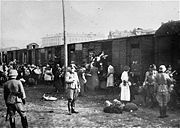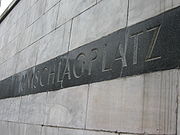
Umschlagplatz
Encyclopedia


The Holocaust
The Holocaust , also known as the Shoah , was the genocide of approximately six million European Jews and millions of others during World War II, a programme of systematic state-sponsored murder by Nazi...
, the Umschlagplatz in the Warsaw Ghetto
Warsaw Ghetto
The Warsaw Ghetto was the largest of all Jewish Ghettos in Nazi-occupied Europe during World War II. It was established in the Polish capital between October and November 15, 1940, in the territory of General Government of the German-occupied Poland, with over 400,000 Jews from the vicinity...
was where Jews gathered for deportation to the Treblinka extermination camp
Treblinka extermination camp
Treblinka was a Nazi extermination camp in occupied Poland during World War II near the village of Treblinka in the modern-day Masovian Voivodeship of Poland. The camp, which was constructed as part of Operation Reinhard, operated between and ,. During this time, approximately 850,000 men, women...
.
During the Grossaktion Warsaw
Grossaktion Warsaw (1942)
The Grossaktion or Gross-Aktion in Warsaw was a Nazi German operation of mass extermination of Jews from the Warsaw Ghetto beginning July 22, 1942. It was a key part of the countrywide Operation Reinhard headed by the SS- und Polizeiführer Odilo Globocnik...
, beginning on July 22, 1942, Jews were deported in crowded freight cars to Treblinka. On some days as many as 7,000 Jews were deported. An estimated 300,000 Jews were taken to the Treblinka gas chambers, and some sources describe it as the largest killing of any single community in World War II. The deportations ended on September 12, 1942.
The Umschlagplatz was created by fencing off a western part of the Warszawa Gdańska
Warszawa Gdanska station
Warszawa Gdańska station is a railway station in northern Warsaw, Poland....
freight train station that was adjacent to the ghetto. The area was surrounded by a wooden fence, replaced later by a wall. Railway buildings and installations on the site as well as a former homeless shelter and a hospital were converted to the prisoner selection facility. The rest of the train station served its normal function for the rest of the city during the deportations.
In 1988, a stone monument resembling an open freight car was built to mark the Umschlagplatz. The monument was created by architect Hanna Szmalenberg and sculptor Władysław Klamerus.

